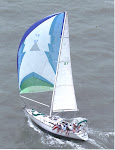This
blog post is about the most remarkable day in White Pepper's
sailing experience—sailing into Paris along the Seine river--
around Notre Dame cathedral, past the Eiffel tower, back around Notre
Dame and then into the Arsenal marine in downtown Paris at the foot
of the Bastille site. But first a bit of build up.
From
Barcelona Jan and I took the train to Narbonne, France. Our mates,
Philip and Gillian, live in Moussan which is a little village out
side of Narbonne. Narbonne is an old Roman garrison town on the
Mediterranean coast. There is a lot to see in Narbonne including a
cathedral, a canal side promenade and an old town. But for me the
best site was an excavated Roman road in the middle of downtown. It
was remarkable to think of the many Romans that trooped over this
road so many years ago.
Philip and Jan stand on old Roman road
Philip
and Gillian, ever the good hosts, took us to Carcassonne which is the
site of the Cathar heresy, crusade and holocaust. It remains
extraordinarily picturesque even 6 centuries after the horror.
Extraordinarily beautiful with great natural defenses
Memorial to Cathars dated 1210
We went to a nearby walled city (that I forget the name of) for lunch.
And
finally we all drive to Migennes in central France. Phillip was
keeping his boat, Zubenel, there. Migennes is a very pretty
French town although the boatyard was fairly scruffy.
We
stayed at primitive canal side quays or in marinas. The last marina
was the Charisse Marina in suburbs of southern Paris.
Finally the big day arrived. We departed Charisse Marina and headed downstream on the Seine. There was one last huge lock to negotiate. The out skirts of Paris are industrial as you might expect, but finally the unmistakable shape of Notre Dame loomed ahead. Norte Dame is on an island. We passed her along the Right Bank. Zubenel passed under all of the exquisitely decorated bridges that span the Seine. We passed the Eiffel Tower before turning around to re pass the Norte Dame along the Left Bank.
Park Decoration in Megennes
Zubenel in the yard
From
Migennes we all drove to the magnificent chateaux Vaux-de-Vicompte.
This remarkable house is the direct precursor of Versailles. When
Louise XIV saw the place he was so jealous that he had the owner
thrown in jail and hired the architect to start building his own
chateaux—Versailles.
View of Vaux de Vicompte from the front. Note how you can see all the way through front door.
Jan
and I pitched in with the painting and getting the boat ready for
launch. Eventually she was ready for splash and off we went down the
Yonne River heading north for Paris.
We
saw many remarkable sights along the river bank. Captain Philip was
cussed out in French by an angry bargeman who though we should have
called as we approached the confluence of the Yonne and Seine.
In one of the many locks along the way
Angry barge operator
Charisse means cherries in French
Finally the big day arrived. We departed Charisse Marina and headed downstream on the Seine. There was one last huge lock to negotiate. The out skirts of Paris are industrial as you might expect, but finally the unmistakable shape of Notre Dame loomed ahead. Norte Dame is on an island. We passed her along the Right Bank. Zubenel passed under all of the exquisitely decorated bridges that span the Seine. We passed the Eiffel Tower before turning around to re pass the Norte Dame along the Left Bank.
Boats going downstream go to the right. Then boats going upstream use the left side or the "left bank".
Eiffel tower in the distance
Less
than half a mile from Notre Dame was our marina—the Arsenal—in
downtown Paris. The Bastille has been torn down, but the dock to the
Bastille remains as one of the boundaries of the Arsenal Marina. The
famous statue of Winged Victory on her column was only a few hundred
yards away on Bastille Square. We had arrived!
Narrow entrance to the Arsenal Marina
Our view from the slip at the Arsenal Marina


























